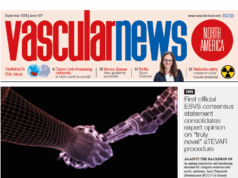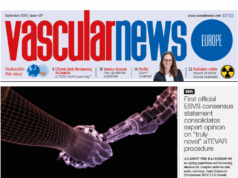 The pilot phase of a new European Venous Registry (EVeR)—designed to illuminate the real-world outcomes of deep venous interventions over a 10-year time horizon—is set to launch this month (September 2024).
The pilot phase of a new European Venous Registry (EVeR)—designed to illuminate the real-world outcomes of deep venous interventions over a 10-year time horizon—is set to launch this month (September 2024).
Developed and hosted by the European Society for Vascular Surgery (ESVS), the registry will be an international repository of deep venous treatment data. These will be used to collect information on the outcomes of venous interventions with the aims of driving quality and safety standards for patients upwards—and shaping future research.
A lack of robust, long-term data to inform the outcomes of deep venous interventions is one of the key reasons behind the initiation of EVeR. Venous disease “is often underappreciated,” committee chair Robert Hinchliffe (University of Bristol, Bristol, UK) tells Vascular News, despite it causing significant patient harm and suffering, as well as “big financial and resource implications for health services across the world, and particularly across Europe”.
Moreover, research attention in the vascular space has long been directed elsewhere, as ESVS president Ian Loftus (St George’s University Hospitals NHS Foundation Trust, London, UK) points out. “We’ve always focused very heavily on arterial disease, on aneurysmal disease,” he says, “but actually venous disease is so important, often involving a younger patient population.”
On the significance of this latter point, Stephen Black (Guy’s and St Thomas’ NHS Foundation Trust and King’s College London, London, UK), who has played a lead role in setting up EVeR, remarks: “Patients need to live with the consequences of our decisions for 50 years, which means we are obliged to get answers as soon as we can to make sure we’re on the right track.” This longstanding need for data has recently been compounded by the requirements of the new Medical Device Regulation (MDR) in Europe, which came into effect in May 2021.

Hinchliffe details that there is a need for improved data on the lifecycle of new devices, of which there have been a proliferation in recent years. “Industry doesn’t have a good, reliable and sustainable method of accessing data for new devices,” he explains, “so really this is another opportunity to be able to collect data on devices to give us an idea of, and industry an idea of, whether their devices are working and what problems may exist.”
Against this backdrop, Loftus recalls that the project started with the European Research Hub (ERH), which he describes as “the research side” of the ESVS. Established in 2022, this initiative seeks to boost participation in clinical vascular research on an international scale.
“I think the [ESVS] is in a very unique position because of its track record in science and because of its reputation pan-Europe but also internationally,” he says of the society’s role in seeing EVeR come to light.
Power of registry data “very significant”
While randomised controlled trials (RCTs) have long been seen as the “gold standard” in terms of data collection and guiding practice, they also have their limitations, as Loftus points out. “You have very limited selection criteria,” he says, with Black adding that RCTs are “enormously expensive” and “have proved extremely difficult to recruit to,” especially in the venous space.
Hinchliffe comments that a registry, on the other hand, is a good way to generate “high-quality, evidence-based data” to help specialists understand practice patterns and outcomes for various interventions and devices.

“The power of registry data is very significant,” Loftus adds, referring to the successes of the UK National Vascular Registry (NVR), which he has been involved in since its inception, as a case in point. “That’s driven some really big quality improvement programmes in vascular surgery—aortic, carotid and lower limb.”
He continues that a registry is particularly well suited to answer the questions that need to be addressed in the venous space. “I think we all want to know what’s really happening out there in the deep venous world,” he says. “Not just what we hear at conferences and not just what we hear from clinical trials, but what’s really happening, and within that try and refine better pathways for patient care.”
On this point, Black notes that EVeR will ensure data are captured across a range of centres and not just those with “exceptional” or “niche” results. “By capturing data in a Europe-wide registry, we can try and get every device that’s implanted into every patient across Europe, so we will really know how these are performing, rather than judging everything by one single lighthouse centre,” he remarks.
There are downsides to registry data—Loftus points out, for example, that “you have to rely on the clinicians to be very honest with their data collection”—but there is agreement that the data collected will not stand alone, but instead form part of and indeed inform a wider evidence landscape.
Hinchliffe likens registry data to one piece of a larger puzzle. “We can’t completely replace RCTs, but we can supplement them,” he says, underlining the fact that registries illuminate outcomes in everyday clinical practice that are often obscured in RCTs.

Black is of the opinion that large-scale, real-world registry data “help to frame a number of questions that may go into RCTs”. He elaborates: “As we improve the quality of the data—a big focus of this registry is to make sure we get quality data—we hope that novel analysis techniques may allow us to draw stronger conclusions from registry data that will take us a long way forward so that the RCTs that come can be shaped properly.”
On this note, Hinchliffe adds that one of the key advantages of registry data is being able to “drive the clinical and research interests in an area”. As a result, he says, “the overall evidence bar and quality bar gets driven up.”
Providing an example of this, Hinchliffe states that the registry will provide an opportunity for specialists to benchmark their activity against other units, using the UK NVR as an example of this having succeeded. A registry, he stresses, should serve to both improve understanding of clinical problems but also “raise the bar” in terms of safety of procedures and activity.
Collaboration is key
Central to the success of EVeR is collaboration, with Loftus stressing the importance of getting support from the broader vascular community for it to reach its full potential. Black notes that this is not aimed at being an exclusively vascular registry. “We’re well aware that venous is treated by multiple specialties,” he says. “It is aimed at being collaborative, and my real hope is that this becomes an exemplar of collaborative working.”
The registry will not only be collaborative across lines of discipline, but also career levels. Hinchliffe underlines a partnership with the junior surgeon-led European Vascular Research Collaborative (EVRC), for example, which he states has been instrumental in the development of the registry so far.
A multidisciplinary research collaborative set up by Hinchliffe and Gert de Borst (UMC Utrecht, Utrecht, The Netherlands), the EVRC encourages young vascular researchers to participate in academic projects. Hinchliffe notes that junior surgeons have played a key role in setting up EVeR due to their extensive experience dealing with multicentre studies across Europe, referencing the work of Florian Enzmann and Alexandra Gratl (both Medical University Innsbruck, Innsbruck, Austria) in particular.
“Patients need to live with the consequences of our decisions for 50 years, which means we are obliged to get answers as soon as we can to make sure we’re on the right track” — Stephen Black
With the stage for the registry now set, Black summarises his expectations for the project moving forward: “I hope that we get a better understanding of outcomes for the patients we’re treating already, a better understanding of who to treat and where we are struggling—so we know where we need to be improving—and get better treatments so that we can shape the future evolution of venous treatment.”
Black also underlines the fact that the registry will ultimately advantage all stakeholders, from surgeons and researchers to industry, regulators and—centrally—patients. “We can create something that is cost-effective for companies, answers questions for us and provides data that support regulatory applications as well as collectively improve treatment for these patients and make sure that we continue to evolve in the right direction,” he says.
Following its pilot phase, EVeR is scheduled to launch in full in September 2025. For more information and details on how to get involved, please visit https://esvs.org/ever-venous-registry/ or email Nhi Cao, European Venous Registry manager ([email protected]).













